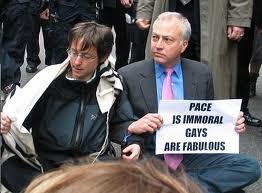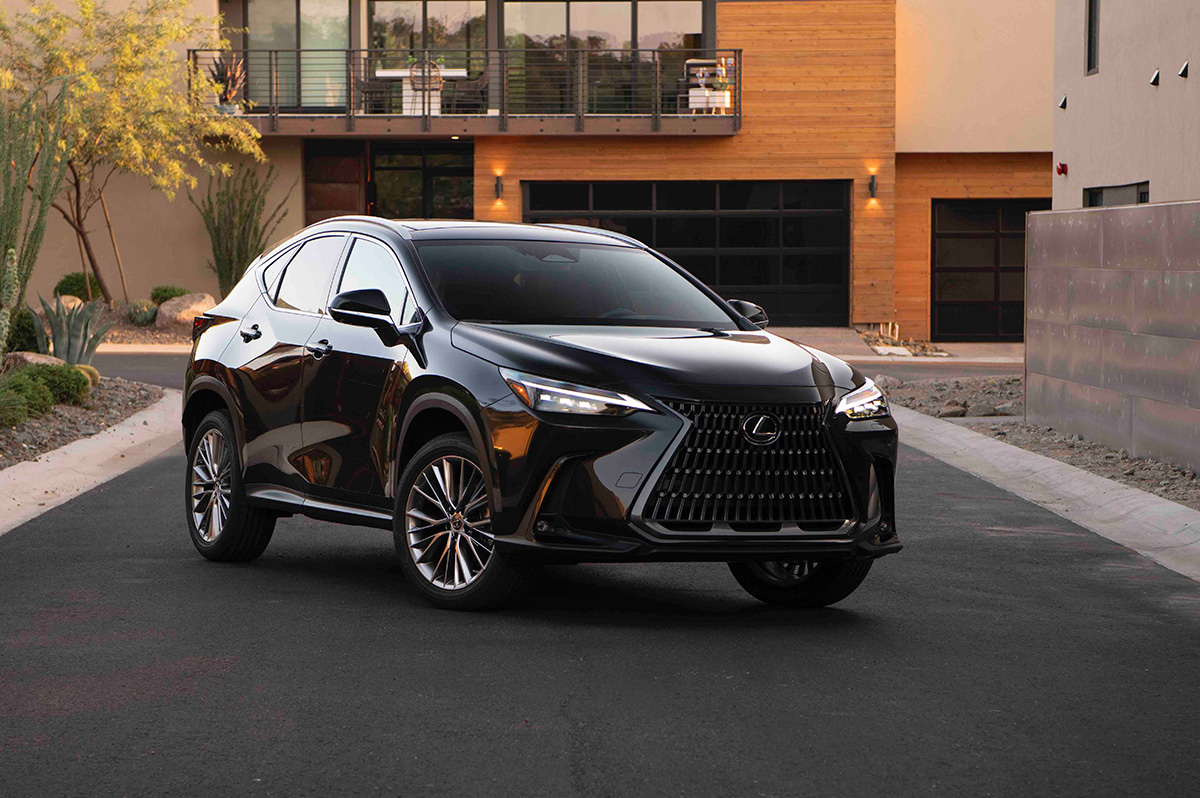Living
New York rabbi celebrates 20 years at LGBT synagogue
Rabbi Sharon Kleinbaum worked at Religious Action Center in D.C. before arriving at Congregation Beit Simchat Torah in 1992


Rabbi Sharon Kleinbaum and then-National Gay and Lesbian Task Force executive director Matt Foreman protest “Don’t Ask, Don’t Tell” in Times Square in 2007 (Photo courtesy of Congregation Beit Simchat Torah)
NEW YORK – Rabbi Sharon Kleinbaum of New York City’s Congregation Beit Simchat Torah had been in rabbinical school for less than a year when she attended a secret conference of gay and lesbian rabbinical and cantorial students and rabbis in Los Angeles in 1986 where attendees had to call a phone number once they landed to find out where the gathering was taking place. The Reconstructionist Jewish movement adopted a non-discrimination policy two years earlier, but the Reform and Conservative traditions still prohibited gay rabbinical students.
They faced potential expulsion over their sexual orientation.
“I was in the first class that was admitted under that [1984] policy,” Kleinbaum told the Washington Blade in a recent interview, noting her own tradition remained hostile to openly LGBT rabbinical students and gay issues in general. “It was all pretty cutting edge. We were all testing the waters. It was a very different time, so we were all figuring out how to both transform the Jewish community internally and the liberal Jewish community was no different.”
Kleinbaum spoke to the Blade shortly after she celebrated her 20th anniversary at Congregation Beit Simchat Torah, the country’s largest LGBT synagogue with 1,100 members that first held services at the Church of the Holy Apostles in Manhattan’s Chelsea neighborhood in 1973. The congregation has since returned to the same Episcopal parish to conduct their Friday night services because it has outgrown its previous location in the West Village.
AIDS was ravaging Congregation Beit Simchat Torah when she became its first full-time senior rabbi in Aug. 1992.
“We just had funerals constantly,” said Kleinbaum, who was director of congregational relations at the Religious Action Center in D.C. from 1990 until she arrived at Congregation Beit Simchat Torah. “I came to CBST and it was in the midst of an epidemic that was being largely ignored by the religious community and certainly by the government. So we were really under siege in those days.”
Roughly one third of Congregation Beit Simchat Torah’s members lost their battle with AIDS, while Kleinbaum said up to 75 percent of her male congregants were living with HIV. She also buried the synagogue’s president who had supported the hiring of a full-time rabbi a month after she arrived at Congregation Beit Simchat Torah.
“The primary motivation for having a rabbi come into the congregation was to respond to this crisis of AIDS. And it was a spiritual crisis that the synagogue was really reeling from the death and the illness and there was no end in sight of course at that time,” said Kleinbaum, who further noted that anti-AIDS stigma at the time only exacerbated the plight of those in the congregation living with the virus. “Religion was used constantly as ammunition, as a weapon against us and against people who were HIV-positive or had AIDS. So my presence to try and project a different image of God and of religion was very important both pastorally and politically.”
Activism extends beyond HIV, LGBT rights
In addition to her HIV/AIDS advocacy, Kleinbaum has publicly backed marriage rights for same-sex couples and other LGBT-specific issues. New York police arrested her and then-National Gay and Lesbian Task Force executive director Matt Foreman during a 2007 protest against “Don’t Ask, Don’t Tell” when they obstructed traffic in Times Square.
Kleinbaum was among the New York Board of Rabbi members taken into custody for civil disobedience during a protest against the 1999 police shooting of unarmed West African immigrant Amadou Diallo in the Bronx. More recently, she has spoken out against the New York Police Department’s controversial stop and frisk policy that critics maintain unfairly targets black and Latinos and other underrepresented groups.
“If we want a country to change and a world to change we have to be deeply in partnership and see our fight and struggle for human rights — it’s not just about who I am as a person literally. This I take from my Jewish tradition,” said Kleinbaum. “We are told over and over and over and over again, remember that you were slaves once in Egypt, therefore make sure you do everything you can to prevent the oppression of anyone else. No one else should be a slave.”
Kleinbaum remained humble when the Blade asked her about those who have identified her as among New York’s most influential Jewish leaders and one of the country’s most important rabbis.
“It’s wonderful to be recognized in that way if it helps also continuing our effort to transform the world,” she said. “I have one agenda; and that’s to transform the world. And I feel that only happens when people are really working hard together.”
Over the last two decades, the congregation’s High Holiday services at the Jacob K. Javits Convention Center have grown to include more than 4,000 people each year. Congregation Beit Simchat Torah also hopes to move into a new building on West 30th Street in Manhattan in 2014.
Judaism itself has changed since Kleinbaum attended rabbinical school in the mid-1980s.
The Reform, Conservative and Reconstructionist movements all admit openly gay rabbinical students and place them in synagogues and other congregational positions. These traditions also recognize same-sex weddings.
“These years since I started rabbinical school have been totally transformative and so it’s been very moving to be part of that,” said Kleinbaum.
As for Congregation Beit Simchat Torah, Kleinbaum said she hopes to further develop its social justice work over the next decade. She would also like to create what she described as an institute that examines the intersection of sexuality and religion.
“The intersection of sexuality and religion is a source of tremendous oppression in the world,” said Kleinbaum. “I’d like to create an institute which focuses on ways that religion can be a voice of liberation in areas of sexuality and religion.”

Did you melt like the Wicked Witch of the West this week?
As summer temperatures rise, keeping your home or apartment cool during a heat wave can become both a comfort issue and a financial challenge. One of the most effective ways to keep a home cool is to prevent heat from entering in the first place. Sunlight streaming through windows can significantly raise indoor temperatures. Consider the following solutions:
• Close blinds or curtains during the hottest parts of the day. Blackout curtains or thermal drapes can reduce heat gain by up to 30%.
• Install reflective window films to block UV rays and reduce solar heat without sacrificing natural light.
• Use outdoor shading solutions such as awnings (yes, the ones you removed because they were “dated”) and shutters to limit direct sunlight.
Fans are a cost-effective way to circulate air and create a wind-chill effect that makes rooms feel cooler.
• Ceiling fans should rotate counterclockwise in the summer to push cool air down.
• Box fans or oscillating fans can be placed near windows to pull in cooler evening air or push hot air out.
• Create a cross-breeze by opening windows on opposite sides of your home and positioning fans to direct airflow through the space.
• For an extra cooling effect, place a bowl of ice or a frozen water bottle in front of a fan to circulate chilled air.
To optimize natural ventilation, open windows early in the morning or late in the evening when outdoor temperatures drop. This allows cooler air to flow in and helps ventilate heat that built up during the day.
Appliances and electronics generate a surprising amount of heat. To reduce indoor temperatures:
• Avoid using the oven or stove during the day; opt for no-cook meals, microwave cooking, or grilling outside.
• Run heat-producing appliances like dishwashers and clothes dryers in the early morning or late evening.
• Unplug electronics when not in use, as even standby power can add heat to your space.
• Switching to energy-efficient LED lightbulbs can also reduce ambient heat compared to incandescent lighting.
If you do use an air conditioner, maximize its effectiveness by:
• Setting it to a reasonable temperature—around 76–78°F when you’re home and higher when you’re away.
• Cleaning or replacing filters regularly to maintain airflow and efficiency.
• Sealing gaps around doors and windows to prevent cool air from escaping. (Didn’t we all have a parent who said, “Close the door. You’re letting all the cool out?”)
• Using a programmable thermostat to optimize cooling schedules and reduce energy use.
If it is not cost-prohibitive, adding insulation in attics and walls can greatly reduce heat transfer. Solar panels that reflect heat can also help, as well as offset the cost of their installation. Adding weatherstripping around doors and windows, sealing cracks, and using door sweeps can make a significant difference in keeping heat out and cool air in.
Natural and eco-conscious methods can also help cool your home.
• Snake plants, ferns, or rubber trees can improve air quality and slightly cool the air through transpiration.
• White or reflective roof paint can reduce roof temperatures significantly.
• Cooling mats or bedding can make sleeping more comfortable without cranking up the A/C.
For renters or those who can’t make permanent modifications, there are still plenty of ways to keep cool.
• Use portable fans and A/C units instead of built-in systems, making sure they are the correct size for your space.
• Removable window film or static cling tinting can reflect heat without violating your lease.
• Install tension rod curtains or temporary blackout panels instead of hardware-mounted window coverings.
• Add draft blockers and weatherstripping tape that can be applied and removed without damage.
• Cover floors with light-colored rugs to reflect heat rather than absorb it.
• If allowed, use temporary adhesive hooks to hang reflective materials or light-filtering fabrics over windows.
Even if your space is warm, you can still take steps to help your body stay cool.
• Wear light, breathable fabrics like cotton or linen.
• Stay hydrated and avoid caffeine or alcohol during peak heat hours.
• Take cool showers or use damp cloths on your neck and wrists to bring your body temperature down.
Keeping your home or apartment cool in the summer doesn’t have to be expensive or energy-intensive. With a few adjustments such as blocking sunlight, optimizing airflow, using fans effectively, and making renter-friendly upgrades, you can create a more comfortable indoor environment while keeping energy bills in check.
Valerie M. Blake is a licensed Associate Broker in D.C., Maryland, and Virginia with RLAH @properties. Call or text her at 202-246-8602, email her at DCHomeQuest.com, or follow her on Facebook at TheRealst8ofAffairs.
Real Estate
The world’s on fire and D.C. is on sale (sort of)
Prices are up, but then again, nothing makes sense anymore

ICE is disappearing people, revered government agencies are shuttering, and who knows if we’ll be in World War III next week? But can you believe prices in D.C. are actually still up 6.3% since last year? It doesn’t make sense, and perhaps that does make sense, because nothing seems to make any sense any more.
That said, there are some parts of our market that are truly suffering. The interest rates, which have been up, up, up for about four years now, are the ongoing rain on our market’s military parade. Combine that with 75,000 federal employees taking a buyout nationwide, and DOGE cuts eliminating around 40,000 federal jobs in the District (per estimates by the D.C. CFO), not to mention thousands of other job losses in non-governmental organizations due to funding and program cuts, and you’ve got a case of uncertainty, and downright unaffordability in the pool of otherwise would-be buyers.
This has had a marked impact on properties that starter-home buyers and low- to mid-level employees would otherwise buy, most notably condominium and cooperative apartment units. These properties have already slowed in our market thanks to the profound impact that higher interest rates have had on their monthly carrying costs—pair that with job insecurity, and a lot of condos are proving to be very difficult to sell indeed.
So how is the average sale price up in our market?
The increase is almost entirely due to the resounding strength of the single-family home market, especially in upper Northwest D.C., where it is still quite common to see bidding wars, even on properties pushing past the $3M mark. It seems that buyers in that echelon are less impacted by a few percentage points in the interest rate, and less concerned about their job security. Notably, those buyers are often married with children and have an absolute need for more space, must stay in the area due to one spouse’s job, or the kid’s friend group, regardless of whether the cost of owning is thousands of dollars more per month than it would have been in 2020 or 2021. The continued appreciation in these neighborhoods defies imagination.
So, what to do if you are not one of those lucky enough to be shopping for a $3M home? The short answer: wait. If you want more space, rent your current place out and learn the joys of being a landlord while someone else pays your mortgage. Need the equity from your current home to buy your next place? Get a home equity line of credit, or loan, and pull the equity out of your current place to buy the next one. Or—and I have never recommended this before in 21 years of being a Realtor—rent for a few years. Sure, I’d love to list and sell your condo so you can climb the real estate ladder, but it might just be a waste of time, money or both if you could just ride out this storm and sell in a DOGE-less future.
All this said, there are some condos that seem to be immune from this recent negative news. Anecdotally, it feels like it’s the truly special ones that do just fine no matter the market. Our recent listing in Capitol Hill had a view from every one of its 15 windows of the Supreme Court. Sold in five days with six offers. Another condo was on the top two floors of a townhouse and had the coolest black wood floors that gleamed like a grand piano. Sold in four days at full price.
So, all is not for naught if you have a condo or home in an area that people want to be in, with nice space, light, amenities and a certain je ne sais quois. And, as long as we have a democracy in a few years, my experience says our market will be back, stronger than ever, really soon.
David Bediz is a Realtor and mortgage loan broker for the Bediz Group LLC and Home Starts Here, LLC. Reach him at [email protected].

In this corner, there’s the Genesis QV70, newly updated and full of glitzy gizmos. And in the opposing corner, there’s the Lexus NX, a fan fave known for comfort and reliability.
Both are strong contenders. Both have proven to be equally adept at bobbing and weaving through traffic. And both can go toe to toe with pricier competitors.
And yet, what would happen when they sparred against each other? Here’s your ringside seat to find out.
GENESIS QV70

$50,000
MPG: 22 city/28 highway
0 to 60 mph: 5.9 seconds
Cargo space: 28.9 cu. ft.
PROS: Stylish. Good value. Lots of standard amenities.
CONS: So-so fuel economy. Quirky dash controls.
IN A NUTSHELL: When it comes to speed, the Genesis QV70 is faster on its feet than the Lexus NX. Neither of these crossover SUVs is a lightweight, but the QV70 offers more potent powerplants—including an all-electric version that zips from 0 to 60 mph in just 3.8 seconds. In other words, Porsche Macan S territory.
The two gas-powered options—a four-cylinder turbo and twin-turbo V6—also got my blood pumping. So did the velvetlike suspension mixed with deft handling and stop-on-a-dime braking. But this adrenaline rush comes at a cost: sacrificing fuel economy.
As for the automaker’s design philosophy—“athletic elegance”—it’s on full display here: an oversized grille inspired by the Genesis emblem, the dramatically arcing silhouette, and those distinct quad headlights and taillights. It’s not easy to stand out when 25% of all vehicles sold in the U.S. are compact crossovers, so kudos to the QV70 for being such a head-turner.
The mod-yet-minimalist styling carries over to the cabin, with its high-quality materials: real-wood accents, soft-touch plastics and a tasteful glass shift knob. New this year is a sweeping 27-inch dashboard monitor, which houses the gauge cluster and infotainment touchscreen. Alas, this display is positioned a bit far from the driver (though I must admit reaching for it did help stretch a few tight back muscles).
Instead of being a costly extra, this gigantic monitor comes standard. So do synthetic leathers seats, nine-speaker stereo, smartphone/wireless connectivity, hands-free liftgate, tons of safety gear and more. Options include a panoramic sunroof, three-zone climate control, 16-speaker Bang & Olufsen audio, synthetic suede headliner, sound-reducing rear windows, automated parking and other goodies.
What’s the score so far? Despite some minor quibbles, the Genesis QV70 is a worthy challenger that pulls no punches.
LEXUS NX

$43,000
MPG: 26 city/33 highway
0 to 60 mph: 8.2 seconds
Cargo space: 22.7 cu. ft.
PROS: Fuel efficient. Comfy seats. Rock-solid reliability.
CONS: Pokey base model. Limited rear storage.
IN A NUTSHELL: Sure, the Lexus NX isn’t as speedy as the Genesis QV70. But, as with the tortoise and the hare, sometimes slow and steady wins the race. And really, it’s only the entry-level NX that feels sluggish, such as when trying to quickly merge into freeway traffic.
Other trim levels, including two hybrid options, are just fine. And no matter the engine choice, the counterpunch here is that these vehicles get better gas mileage: 20% higher fuel economy than in either the four-cylinder or V6 in the Genesis. The two NX hybrids are even more green, with the high-end plug-in version able to travel up to 37 miles on electric power alone. One downside: There is no all-electric NX—well, at least not yet.
As with parent-company Toyota, Lexus offers stellar vehicle reliability—often ranked No. 1 in dependability and crash-test surveys year after year. Lexus vehicles generally hold their value better than Genesis, because this newer brand has a shorter history. Lexus also has a larger dealer network, though the number of Genesis dealerships is growing.
But when it comes to cargo space, the NX is about two inches shorter and narrower than the QV70, which has more stowage area. And Genesis handling is sportier, though the Lexus feels sure and well-grounded.
Luxe interior amenities are basically the same in both vehicles. But interior styling in the QV70 is trendy, while the NX is more understated. In other words, a choice between sassy and classy.
This is a very competitive vehicle segment, with Euro models like the Audi Q5, BMW X3 and Mercedes GLC also duking it out in what seems like a clash of the titans.
But as for the Genesis QX70 or Lexus NX, which is the winner? For me, both are real knockouts—so I’d call it a draw.
-

 U.S. Supreme Court3 days ago
U.S. Supreme Court3 days agoSupreme Court upholds ACA rule that makes PrEP, other preventative care free
-

 U.S. Supreme Court3 days ago
U.S. Supreme Court3 days agoSupreme Court rules parents must have option to opt children out of LGBTQ-specific lessons
-

 National5 days ago
National5 days agoEvan Wolfson on the 10-year legacy of marriage equality
-

 Congress4 days ago
Congress4 days agoSenate parliamentarian orders removal of gender-affirming care ban from GOP reconciliation bill










